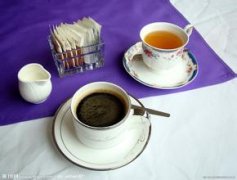Yunnan Arabica coffee quality introduction Tin card coffee estate varieties planting market price introduction

Yunnan can be said to be the only province where Arabica is still planted in a large area. The main planting areas are concentrated in Lincang, Dehong, Baoshan, western Yunnan and Pu 'er Banna, southern Yunnan. The coffee introduced by missionaries in the 19th century is mainly Robusta, and no large-scale planting has been carried out since then. In the 1950s, experts assisted by the Soviet Union put the two mainstream Arabica varieties in the world: Iron pickup typica and bourbon were brought to Baoshan, Yunnan Province for cultivation and promotion, and received high praise. Later, due to special period, scientific research and planting tended to stagnate. After reform and opening up, with the efforts of local agricultural experts, the iron pickup varieties cultivated by Baoshan state-owned Lujiang Farm and Xincheng Youth Farm also won the first place in the international coffee competition, and received rave reviews. However, the Chinese people's cognition of coffee made us not increase too much interest in planting. Since the early 1990s, in order to improve the planting enthusiasm of coffee farmers, Baoshan Thermal Crop Institute has introduced the Katim variety bred by Portugal Coffee Rust Research Center through the cross of Timer (medium grain, Tim) and Caturra (small grain, Kadura), and has been popularized and planted with numerous titles. Up to now, this variety has solved many factors such as disease and insect pests disaster and drought resistance very well. The important thing is that the yield per mu has nearly doubled. Although the planting enthusiasm of coffee farmers has been improved, However, this also became the reason for the low quality of Yunnan coffee from then on; At the same time, Nestle and Maxwell entered China and began to promote coffee varieties suitable for instant coffee in Pu 'er and other places: S288, natural hybridization of large seed and small seed, and self-breeding of Indian Arabica Kent hybrid offspring S26, first-class rust resistance, but planting difficulty and adaptability were relatively low, and planting was basically stopped at the beginning of the 20th century.
Speaking of which, I think there should be a judgment on Yunnan coffee varieties. What about the excellent iron pickups and bourbon? New promotion planting, or left a lot of hills, continue to plant old varieties of coffee, but, popular, backward places do not have the origin and protection of a single species, a mountain, 10 households, all kinds of, a gust of wind blowing, pollen flying everywhere... hehe. The problem of variety makes Yunnan coffee really lose at the starting line.
The Sui Dynasty eliminated the separatist forces and Yunnan was placed under the direct rule of the central government again. In the early Tang Dynasty, it basically restored the scale of prefectures and counties in the Han and Jin Dynasties. In 707 AD, the Tang Dynasty defeated the Tubo expansion forces invading Erhai Lake in the south and established Iron Pillar to record merit. In 738 AD, Nanzhao unified Erhai Lake area and conferred the title of "King of Yunnan" on Polo Pavilion. Nanzhao period territory east Guizhou, west Irrawaddy River, south Xishuangbanna, north Dadu River; southeast boundary now Vietnam, southwest boundary now Myanmar; northwest and Tubo neighbors, northeast and Rongzhou (now Yibin) opposite the vast territory. Nanzhao internal repair system, built East City (now Kunming), built Chongsheng Temple three pagodas.
In the seventh year of the Jin Dynasty (271 years), it was renamed Ningzhou. 282), the second year of Taikang, the province was restored to Yizhou and the South Yi Colonel was set up. 2003 - 2004 (1993), the second year of its existence. In the eighth year of Xianhe of the Eastern Jin Dynasty (AD 333), Li Xiong sent Li Shou to lead his troops to capture Nanzhong. Li Shou was granted the title of "King of Jianning" and Cuanchen was the governor of Jiaozhou. 338 years (338 years), divided into Anzhou. In the fifth year of Xiankang (AD 339), Cuanchen surrendered to Jin Dynasty, and Jin Dynasty granted Cuanchen the title of governor of Ningzhou and recognized its hereditary status. From then on, the Cuan clan ruled Yunnan for 400 years. In the second year of Yuanfeng of Western Han Dynasty (AD 109), Emperor Wu opened the western region to the south, with 24 counties and Yunnan as one. There are three ways to name the county Yunnan. One is that colorful clouds appear in the south. When the county was founded, colorful clouds appeared in Longxing Mountain to the north of Yunnanyi Village, and the county seat was called Yunnan to the south of colorful clouds. The other is that Yunshan Mountain is called Yunnan to the south of Yunshan Mountain. The third is that Emperor Wu of the Han Dynasty pursued dreams. It is said that Emperor Wu of the Han Dynasty dreamed of colorful clouds at night and sent messengers to pursue dreams. In today's Xiangyun County, Yunnan County was located.
Important Notice :
前街咖啡 FrontStreet Coffee has moved to new addredd:
FrontStreet Coffee Address: 315,Donghua East Road,GuangZhou
Tel:020 38364473
- Prev

A brief introduction to the History and Culture of the Origin and Development of Yunnan small Coffee
Yunnan has a long history of growing coffee and has a unique climate advantage. Yunnan small grain coffee has the characteristics of strong but not bitter, fragrant but not greasy, slightly sour and so on. According to the International Coffee Organization, Yunnan small-grain coffee is similar to Colombian small-grain coffee in quality, and its products are highly competitive in the market. At present, 95% of China's coffee raw materials are produced in Yunnan. Therefore, Yunnan's coffee industry is responsible for
- Next

A brief introduction to the planting situation of Yunnan Tieka Coffee Fine Coffee beans, Geography, Climate and altitude
Baoshan: the cultivation of coffee in Baoshan began in the mid-1950s, and the first coffee seedling was introduced by the late patriotic overseas Chinese Mr. Liang Jinshan in Southeast Asia. The local famous Lujiangba small grain coffee is of excellent quality. It was rated as first class in London, England as early as the late 1950s. In recent years, with the expansion of international trade, Lujiangba's small-grain coffee is more famous. Europe, the United States, Afghanistan
Related
- Detailed explanation of Jadeite planting Land in Panamanian Jadeite Manor introduction to the grading system of Jadeite competitive bidding, Red bid, Green bid and Rose Summer
- Story of Coffee planting in Brenka region of Costa Rica Stonehenge Manor anaerobic heavy honey treatment of flavor mouth
- What's on the barrel of Blue Mountain Coffee beans?
- Can American coffee also pull flowers? How to use hot American style to pull out a good-looking pattern?
- Can you make a cold extract with coffee beans? What is the right proportion for cold-extracted coffee formula?
- Indonesian PWN Gold Mandrine Coffee Origin Features Flavor How to Chong? Mandolin coffee is American.
- A brief introduction to the flavor characteristics of Brazilian yellow bourbon coffee beans
- What is the effect of different water quality on the flavor of cold-extracted coffee? What kind of water is best for brewing coffee?
- Why do you think of Rose Summer whenever you mention Panamanian coffee?
- Introduction to the characteristics of authentic blue mountain coffee bean producing areas? What is the CIB Coffee Authority in Jamaica?

